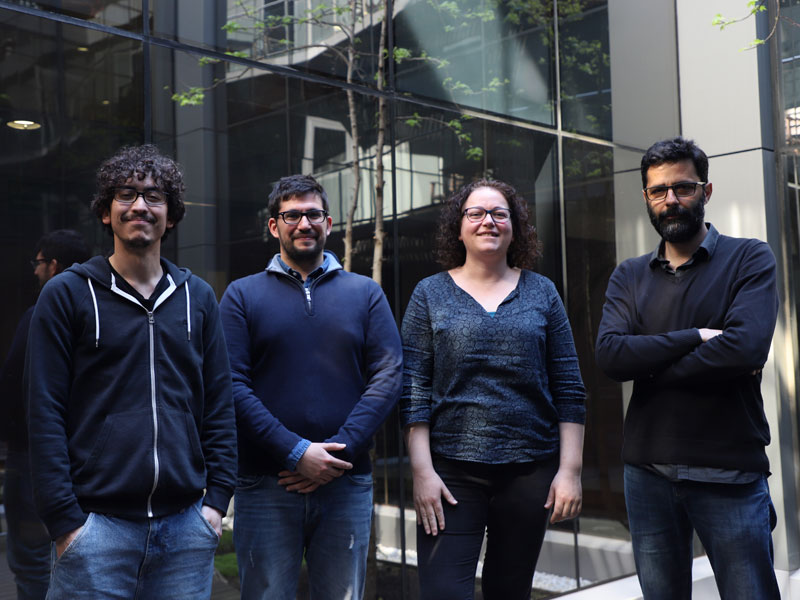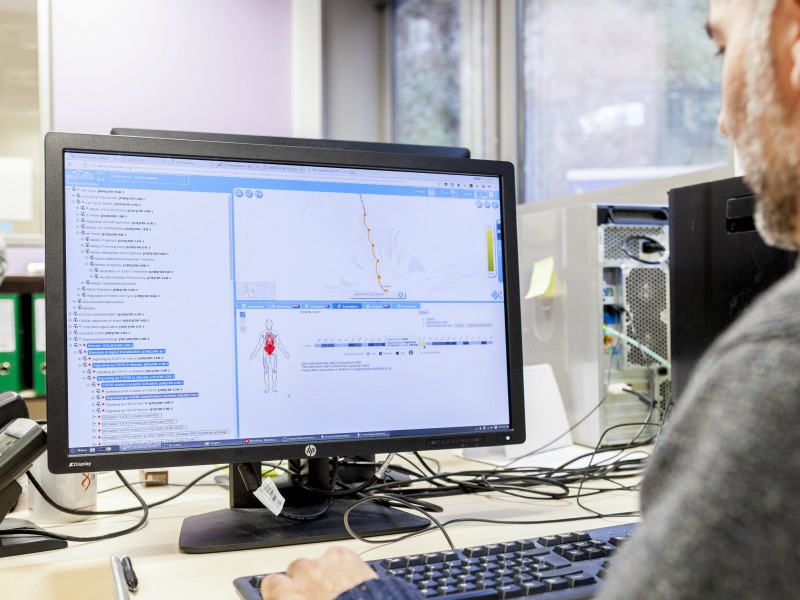GCAT publishes its first results on a variety of diseases

Dr Rafael de Cid joined the institute in 2012 as the Scientific Director of the GCAT. Since then, the Project has been successfully set up and is now seeing the first research results. We asked him about the five publications that have appeared so far this year and what GCAT has in the pipeline.
Q: It took four years to set up the GCAT, is that part now complete?
RdC: Yes, it is. The setting up phase was difficult, but building anything from scratch is hard. We were privileged to be able to count on the input of the Director, Manuel Perucho, Victor Moreno and other very experienced researchers from the early stages and we continue to work with them on new developments. Our team have worked closely with the Blood and Tissue Bank to recruit our 20,000 volunteers and take blood samples, body metrics and complete the detailed questionnaires about family health history, diet, exercise, exposure to sun and other environmental factors and then to process and store the samples.That stage was completed earlier this year and we have now finished analysing the first 5,000 genomes.Meanwhile, the results of the first studies using our GCAT data and some using our analytical techniques are now being published.
Q: Have you collected all the information you need from the participants?
RdC: No indeed not, this is a prospective cohort, which means that we have taken the initial samples and will follow the participants over time, initially for 20 years, to see how their health and also the external factors change.It is this continually growing data bank that will allow us to tease out the greatest risk factors of the typical chronic diseases such as diabetes, cancer, cardiovascular and neurodegenerative diseases amongst others. Some of these factors are within our genes, others are in the environment but the big question is how much each one affects the risk of developing a certain disease.
Q: And this cohort is one of many in the world that can all be added together?
RdC: From the beginning we have set up the GCAT and processed the samples according to international standards. This means our data can be pooled with data from other countries or used to compare risk of certain diseases in different populations in studies such as some done by researchers from our institute some years ago that found that Japanese and Caucasian people have different susceptibilities to lung cancer and indeed are susceptible to different types of lung cancer. Many international studies need large numbers of samples from different areas and as part of the international network we will be participating in many of them.

Q: And so far you have published six papers this year.
RdC: Now we are starting to see the results of research that has been taking place over recent years with GCAT data. The first paper published in January in the British Medical Journal (BMJ Open) defined the cohort and presented it to the international research community. After this we have started publishing the results of our own studies. Using all the data we have on body size and shape, skin, eye and hair colour etc. for our participants we published a paper in the British Medical Journal on looking for the multiple genetic factors behind these traits. Inheritance of these characteristics is complex and can depend on several genes and our results show that data sets from large populations can be analysed to identify and quantify the weight of the multiple factors responsible for physical features. We then carried out meta-analysis which is to check the results we had found looking at data from our 5,000 samples against the data for a group of 336,000 samples from the UK Biobank and this confirmed our findings.
Q: And this use of another large group to check results, the meta-analysis, is something the GCAT can also be used for?
RdC: Exactly, just as we can check our results against 336,000 samples from the UK Biobank, other researchers can use GCAT sample/data to validate studies they have carried out. This is another important service the GCAT Cohort can provide.
Q: So can the multitrait genome analysis be used to look for multiple factors behind diseases, not just physical characteristics?
RdC: Well of course that is the main aim. We and other groups collaborating with GCAT are continually developing data analysis techniques to extract this information. The more sophisticated our tools the better the results and we are only just beginning to mine this data.
Q: You have also published a paper on lung cancer, is this data from the cohort?
RdC: No, our group does not contain enough cancer patients, most of our volunteers are healthy and we will follow them as diseases develop.In this case, while we were setting up the collection of samples we used the statistics and imputation analysis expertise of our team to analyse data from a collaboration that includes researchers from our institute. Our analysis of only 155 patients revealed a gene that can be used to predict the response of small cell lung cancer patients to first line chemotherapy. Again this was checked against data for an independent set of cancer patients and confirmed, the results have been published in Cancer Treatment and Research Communications.
Q: So the GCAT cohort and your expertise can be used to study all kinds of diseases?
RdC: That is the enormous value of this collection of samples and associated data, it can be used to study many diseases and many aspects of human health.Equally our skills can be applied to many areas. For example, we are working with groups from the IrsiCaixa, also on Campus Can Ruti. In one study, published in Antiviral Research, we helped with the genetic analysis to identify a marker for a poor prognosis after infection with the hepatitis C virus (HPC) in patients with HIV infections.The same marker is a possible target for medication to boost the immune system and fight the infection better.We have several ongoing studies with IrsiCaixa and this is a very productive line of research.
Q: The GCAT Project aims to find the factors behind the chronic diseases typical in an aging population, but your latest paper in Scientific Reports actually analyses the connection between different chronic diseases and their effect on lifespan, why is this important?
RdC: It is a key public health issue; most elderly people have more than one chronic condition and then may have other problems such as falls.We don't yet know how these illnesses affect one another, but we do know that together they are difficult to treat and lower quality of life.We again contributed to an analytical study, this time using electronic medical records that showed connections between different diseases.This found, for example, a connection between changes in lipid metabolism, breast cancer, diabetic neuropathy and nutritional anaemia.The study was carried out in collaboration with the IDIBELL and IDIAP Jordi Gol. It is just the beginning as there is a lot of work to be done in this area.
Q: So we can truly say that the GCAT Project has reached cruising speed?
RdC: Well it has been launched and it is sailing very well.At the moment we have a lot of new projects underway and others in the pipeline. We are studying obesity, ictus and hereditary cancer amongst other diseases, as well as working on a method to recognize family members in groups of samples to avoid biased results.We have collaborations with the Catalan Institute of Oncology (ICO), Eurecat, the Institute of Biotechnology and Biomedicine (IBB) at the Universitat Autònoma de Barcelona, the Polytechnic University of Catalonia (UPC), ISGlobal, the Barcelona Supercomputing Centreand other institutes on and outside our campus.The team is prepared and we have accumulated considerable expertise in the complex analysis of large data sets, so to use your metaphor, I would say we will soon be at full cruising speed and competing at international level and we will reach Olympic level in the short to mid-term.
Original papers
GCAT'Genomes for life: a prospective cohort study of the genomes of Catalonia. Obón-Santacana M, Vilardell M, Carreras A,et al. GCAT'Genomes for life: a prospective cohort study of the genomes of Catalonia. BMJ Open2018;8:e018324. doi:10.1136/bmjopen-2017-018324
Multitrait genome association analysis identifies new susceptibility genes for human anthropometric variation in the GCAT cohort. Galván-Femenía I, Obón-Santacana M, Piñeyro D, et al. Journal of Medical Genetics Published Online First: 30 August 2018. doi: 10.1136/jmedgenet-2018-105437
Genomic profiling in advanced stage non-small-cell lung cancer patients with platinum-based chemotherapy identifies germline variants with prognostic value in SMYD2 Galván-Femenía I, Guindo M, Duran X, Calabuig-Fariñas S, Mercader JM, Ramirez JL, Rosell R7, Torrents D, Carreras A, Kohno T, Jantus-Lewintre E, Camps C, Perucho M, Sumoy L, Yokota J, de Cid R. Cancer Treatment and Research Communications, Volume 15, 2018, Pages 21-31
ADAR1 affects HCV infection by modulating innate immune response. Antiviral Research.Pujantell M, Franco S, Galván-Femenía I, Badia R, Castellví M, Garcia-Vidal E, Clotet B, de Cid R, Tural C, Martínez MA, Riveira-Muñoz E, Esté JA, Ballana E. Antiviral Research, Volume 156, August 2018, Pages 116-127.
Disease networks identify specific conditions and pleiotropy influencing multimorbidity in the general population. Amell A1, Roso-Llorach A2,3, Palomero L4, Cuadras D5, Galván-Femenía I6, Serra-Musach J4, Comellas F1, de Cid R7, Pujana MA8, Violán C9,10. Sci Rep. 2018 Oct 29;8(1):15970. doi: 10.1038/s41598-018-34361-3.
Pipeline design to identify key features and classify the chemotherapy response on lung cancer patients using large-scale genetic data María Gabriela Valdés, , Iván Galván-Femenía, Vicent Ribas Ripoll, Xavier Duran, Jun Yokota, Ricard Gavaldà, Xavier Rafael-Palou and Rafael de Cid BMC Systems Biology 2018, 12 (suppl):97 https://doi.org/10.1186/s12918-018-0615-5
